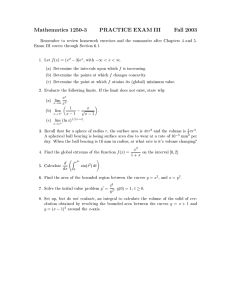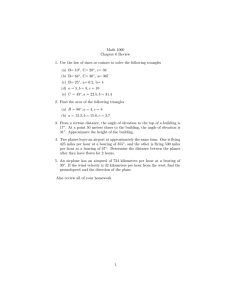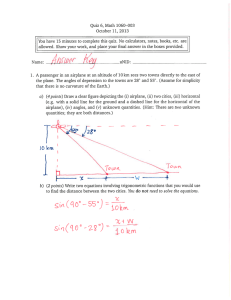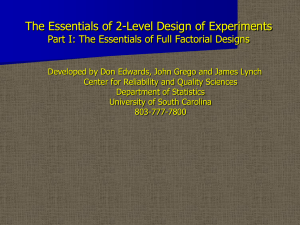Design, Modelling and Analysis of a Single Raw Increase its Life.
advertisement
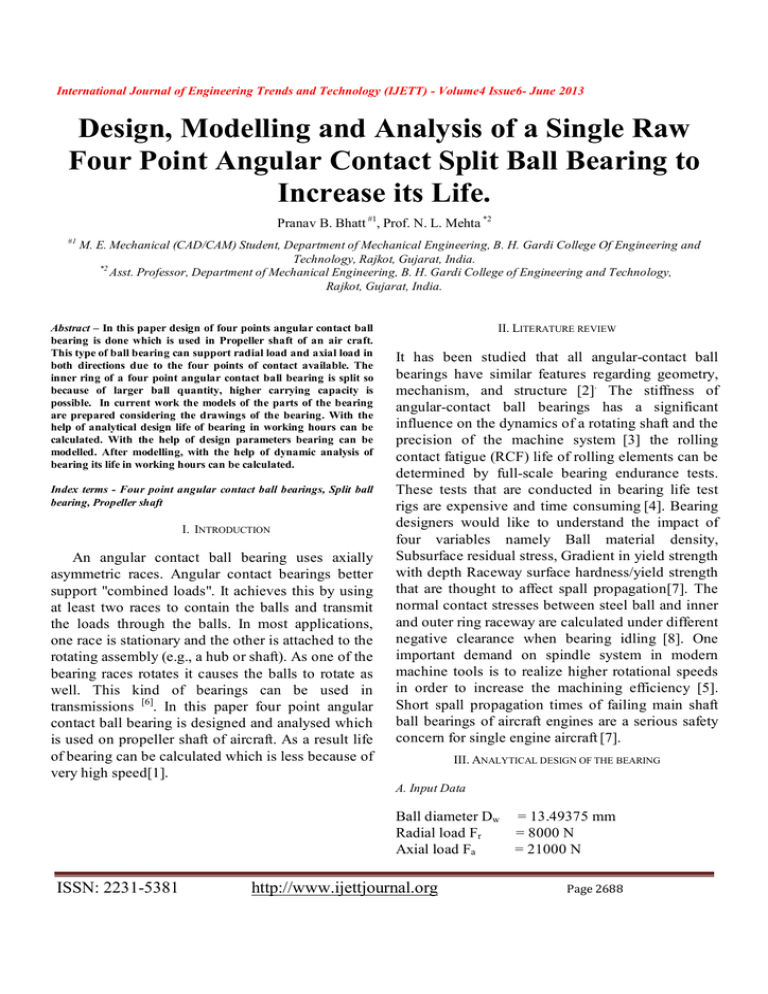
International Journal of Engineering Trends and Technology (IJETT) - Volume4 Issue6- June 2013
Design, Modelling and Analysis of a Single Raw
Four Point Angular Contact Split Ball Bearing to
Increase its Life.
Pranav B. Bhatt #1, Prof. N. L. Mehta *2
#1
M. E. Mechanical (CAD/CAM) Student, Department of Mechanical Engineering, B. H. Gardi College Of Engineering and
Technology, Rajkot, Gujarat, India.
*2
Asst. Professor, Department of Mechanical Engineering, B. H. Gardi College of Engineering and Technology,
Rajkot, Gujarat, India.
Abstract – In this paper design of four points angular contact ball
bearing is done which is used in Propeller shaft of an air craft.
This type of ball bearing can support radial load and axial load in
both directions due to the four points of contact available. The
inner ring of a four point angular contact ball bearing is split so
because of larger ball quantity, higher carrying capacity is
possible. In current work the models of the parts of the bearing
are prepared considering the drawings of the bearing. With the
help of analytical design life of bearing in working hours can be
calculated. With the help of design parameters bearing can be
modelled. After modelling, with the help of dynamic analysis of
bearing its life in working hours can be calculated.
Index terms - Four point angular contact ball bearings, Split ball
bearing, Propeller shaft
I. INTRODUCTION
An angular contact ball bearing uses axially
asymmetric races. Angular contact bearings better
support "combined loads". It achieves this by using
at least two races to contain the balls and transmit
the loads through the balls. In most applications,
one race is stationary and the other is attached to the
rotating assembly (e.g., a hub or shaft). As one of the
bearing races rotates it causes the balls to rotate as
well. This kind of bearings can be used in
transmissions [6]. In this paper four point angular
contact ball bearing is designed and analysed which
is used on propeller shaft of aircraft. As a result life
of bearing can be calculated which is less because of
very high speed[1].
II. LITERATURE REVIEW
It has been studied that all angular-contact ball
bearings have similar features regarding geometry,
mechanism, and structure [2]. The stiffness of
angular-contact ball bearings has a significant
influence on the dynamics of a rotating shaft and the
precision of the machine system [3] the rolling
contact fatigue (RCF) life of rolling elements can be
determined by full-scale bearing endurance tests.
These tests that are conducted in bearing life test
rigs are expensive and time consuming [4]. Bearing
designers would like to understand the impact of
four variables namely Ball material density,
Subsurface residual stress, Gradient in yield strength
with depth Raceway surface hardness/yield strength
that are thought to affect spall propagation[7]. The
normal contact stresses between steel ball and inner
and outer ring raceway are calculated under different
negative clearance when bearing idling [8]. One
important demand on spindle system in modern
machine tools is to realize higher rotational speeds
in order to increase the machining efficiency [5].
Short spall propagation times of failing main shaft
ball bearings of aircraft engines are a serious safety
concern for single engine aircraft [7].
III. ANALYTICAL DESIGN OF THE BEARING
A. Input Data
Ball diameter Dw
Radial load Fr
Axial load Fa
ISSN: 2231-5381
http://www.ijettjournal.org
= 13.49375 mm
= 8000 N
= 21000 N
Page 2688
International Journal of Engineering Trends and Technology (IJETT) - Volume4 Issue6- June 2013
Material
= 440C
RPM
= 25000
No. of balls Z
= 15
Ball pitch diameter = 92.5 mm
No. of rows i
=1
Fa = Axial load
Pr = 1 x 8000 + 0
Pr = 8000N
B. Contact Angle
Por = X Fr + Y Fa[1]
Where,
X = 0.5
Y = 0.29
From ISO Standards,
Por = 0.5 x 8000 + 0.27 x 21000
Por = 9670 N
E. Static Equivalent Radial Load
α = cos-1[1- {Gr / 2(ri + rc - Dw)}][12]
= cos-1[1- {0.15 / 2(7.06 +7.06 - 13.49375}]
α = 28.5○
where,
Gr = radial clearance
ri = inner groove radius
rc = outer groove radius
α = contact angle
Dw = Ball diameter
Dw x cosα / dpw
= (13.49375 x cos 28.5 ○) / 92.5
= 0.128
Where,
Dw = Ball diameter
α = contact angle
dpw = Ball pitch diameter
Therefore, as per ISO standards,
Fc = 58.15 from interpolation.
Where,
Fc = factor for dynamic load rating calculation
C. Dynamic Load Ratings
Cr = Dynamic equivalent radial load
Cr = Fc (i x cosα)0.7 x (Z)2/3 x (Dw)1.8[11]
= 58.15(1 x cos 28.5)0.7 x (15)2/3 x (13.49375)1.8
Cr = 34960.55 N
D. Dynamic Equivalent Radial Load
Pr = X Fr + y Fa[1]
Where,
X = radial load factor = 1
Y = Thrust load factor = 0
Fr = Radial load
ISSN: 2231-5381
F. Basic Life Ratings
L0 = (Cr/Pr)k [11]
Where,
Cr = Basic dynamic load rating
Pr = Dynamic radial load
K = 3 for ball bearings
L10 = 34960.55/8000
= 88.457
G. Life in Revolutions
L = L10 x 106[11]
= (Cr/Pr)k x 106
= 83.457 x 106 Revolutions
Where,
L = life in revolution
H. Life in Working Hours
L = 60 x N x Lh[11]
Lh = L/60 x N
= 83.457 x 106/60 x 25000
Where,
Lh = Life in
N = speed of bearing in rpm
Lh = 55.638 hours
http://www.ijettjournal.org
Page 2689
International Journal of Engineering Trends and Technology (IJETT) - Volume4 Issue6- June 2013
B. Model and Geometry of Inner Race of the Bearing
IV. ASSEMBLY OF THE BEARING
Figure 1 Assembly of the Bearing[10]
V. DEVELOPED DESIGN
Table 1 Developed design
Figure 2 Model and geometry of inner race of the Bearing
Parameters
No. Of Balls
Developed
design
15
Ball diameter
Contact angle
13.49375
28.5
○
Life in
working
hours
C .Model and Geometry of Cage of the Bearing
55.638
VI. MODELING OF THE BEARING
A. Model and Geometry of Outer Race of the Bearing
Figure 3 Model and geometry of cage of the Bearing)
D. Model and geometry of Ball of the Bearing
Figure 1 Model and Geometry of outer race of the Bearing
Figure 4 Model and geometry of Ball of the Bearing
ISSN: 2231-5381
http://www.ijettjournal.org
Page 2690
International Journal of Engineering Trends and Technology (IJETT) - Volume4 Issue6- June 2013
C. Result Obtained by Dynamic Analysis in Form of Stress
E. Assembly Model of the Bearing
Here, there are results in form of Von-misses Stress
produced due to rotation of bearing at 25000 RPM.
Figure 5 Model and geometry of assembly of the Bearing
VII. DYNAMIC ANALYSIS RESULTS
A. Load Direction for Linear Static Analysis in Static
Mode
Figure 7 Stresses on Outer Race
Figure 6 Load directions in static Condition
[12]
B. Pre-Processing for Dynamic Analysis of Bearing
Figure 8 Stresses on Inner Race
For the analysis of bearing boundary condition and
force these parameters are required to be applied
and then next step is meshing. Meshing is nothing
but dividing objet in to small parts for results on that
all different parts. In our object meshing is done by
tetra method, fixed support applied at cage as a
boundary condition, frictionless support applied at
inner & outer ring due to lubrication, rotational
force applied at a centre (25000 RPM), Axial force
applied at outer ring with value of 21000 N.
Figure 9 Stresses on Cage
ISSN: 2231-5381
http://www.ijettjournal.org
Page 2691
International Journal of Engineering Trends and Technology (IJETT) - Volume4 Issue6- June 2013
(Figure 10 Stresses on Balls)
Figure 12 Life of Cage
D. Results Obtained by Dynamic Analysis in Form of Life
Here, main objective of this research is to increase
bearing life in working hours. It is resulted by
changing inner grove radius, outer groove radius,
contact angle, number of balls, and diameter of
balls. After these changes following results are
obtained.
Figure 13 Life of Inner Race
Fig. 11.Life of Outer Race
Figure 14 Life of Balls
ISSN: 2231-5381
http://www.ijettjournal.org
Page 2692
International Journal of Engineering Trends and Technology (IJETT) - Volume4 Issue6- June 2013
VIII. RESULTS AND CONCLUSION
[11] ISO Standards (IS: 3821, IS 3823:1988, ISO76:1987)
[12] Ball Bearing Displacement-NMB, http://www.googlescholar.com
Table 2 Comparison of life of the Bearing
Life in working hours by design
55.638 hours
Life in working hours by analysis
70 hours
In analytical design, by increasing numbers of ball,
decreasing ball diameter, and changing the contact
angle, the life in working hours can be increased.
From the results of analytical design and analysis it
can be seen that life of bearing is nearly same in
both cases. Due to higher stresses, the life in
working hours is limited to hours. It can be further
increased by changing the parameters, material and
lubrication of the Bearing.
IX. REFERENCES
[1] Robert P. Tata, “Ball Bearing Design”.vol.II
[2]
Jing Liu, Yimin Shao, Teik C. Lim, “Vibration analysis of ball bearings
with a localized
defect applying piecewise response function”,
Mechanism and Machine Theory 56 (2012) 156–169.
[3] Yuan Kanga, Chih-Ching Huang, Chorng-Shyan Lin, Ping-Chen Shen,
Yeon-Pun Changa, “Stiffness determination of angular-contact ball
bearings by using neural network”, Tribology International 39 (2006)
461–469.
[4] Mohsen Mosleh, Keron Bradshaw, “Role of component configuration in
evaluation of accelerated rolling contact fatigue of ball bearings”, Wear
271 (2011) 2681– 2686.
[5] Shoji Noguchi, Tohru Kanada b, “3- and Contact Point Spindle Bearings
-a new Approach for High Speed Spindle Systems”, Laboratory of
Machine Tools and Production Engineering. Aachen. Germany
[6]
J. Jedrzejewski, W. Kwasny, “Modelling of angular contact ball
bearings and axial displacements for high-speed spindles”, CIRP Annals
- Manufacturing Technology 59 (2010) 377–382.
[7] Nathan A. Branch, Nagaraj K. Arakere, Nelson Forster, Vaughn
Svendsen, “Critical stresses and strains at the spall edge of a case
hardened bearing due to ball impact”, International Journal of Fatigue
47 (2013) 268–278.
[8] You Hui-yuan, Zhu Chun-xi, Li Wu-xing, “Contact Analysis on Large
Negative Clearance Four-point Contact Ball Bearing”, Procedia
Engineering 37 ( 2012 ) 174 – 178.
[9]
[10]
Machine Design by R.C.Patel. B.E (Mech.) M.S. University Baroda.
Vol.II.
AEC Bearings catalogues.2010-2011.
ISSN: 2231-5381
http://www.ijettjournal.org
Page 2693
